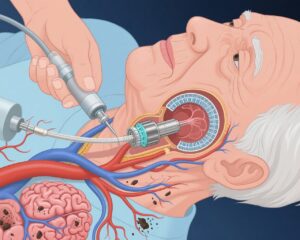Study Background and Disease Burden
Mitral regurgitation (MR) is a common valvular heart disease characterized by the backward flow of blood from the left ventricle into the left atrium during systole. If left untreated, MR leads to progressive left ventricular dysfunction, heart failure, atrial arrhythmias, pulmonary hypertension, and increased mortality. Surgical intervention, primarily mitral valve surgery (MVS) via repair or replacement, remains the cornerstone of treatment. However, despite advances in diagnostics and surgical techniques, gaps exist in the comprehensive understanding of the real-world clinical presentation, timing of intervention, and surgical outcomes across diverse patient populations.
Insight into these aspects is crucial for evaluating adherence to guidelines, recognizing selection biases in surgical referral, and ultimately improving quality of care. The MITRACURE registry, encompassing over 3,500 consecutive adult patients undergoing MVS for MR across multiple centers in France and Canada in 2019, provides such a contemporary and comprehensive dataset. This international retrospective registry reflects “allcomer” real-world practice, enabling an evaluation of current management strategies and their outcomes in unselected MR populations.
Study Design
MITRACURE is a large multicenter, retrospective registry collecting detailed clinical, echocardiographic, and procedural data of adult patients who underwent isolated or combined mitral valve surgery for MR during 2019 in 40 centers across France and Canada. Patients with isolated mitral stenosis or those with prior mitral valve interventions were excluded to specifically assess the population undergoing surgery for MR.
Data were obtained through thorough chart abstraction and site reporting, capturing demographics, etiology of MR, preoperative clinical status including New York Heart Association (NYHA) functional class, heart failure presence, atrial arrhythmias, left ventricular ejection fraction (LVEF), pulmonary pressures, surgical details including repair vs. replacement rates, and in-hospital mortality. This design allows evaluation of management patterns, timing of surgery, procedural outcomes, and safety profiles in a large, real-world cohort.
Key Findings
In total, 3,522 patients underwent MVS for MR in 2019, with 48% receiving combined procedures (e.g., concomitant coronary or other valve surgeries). The mean age was 65 years (±12), and women represented 35% of the cohort. Myxomatous degeneration was the predominant etiology (61%), followed by functional MR (9%), infective endocarditis (9%), and rheumatic disease (7%).
A notable deficiency was found in MR quantification, performed in only 43% of patients, highlighting potential areas for diagnostic improvement.
Clinical presentations were frequently advanced: 43% of patients were in NYHA functional class III/IV, reflecting symptomatic heart failure, and 30% had documented congestive heart failure. Almost half (47%) were on diuretic therapy, and 22% presented with atrial fibrillation or flutter. Importantly, 35% had reduced left ventricular ejection fraction, and 22% displayed pulmonary hypertension with systolic pressures ≥50 mm Hg—both indicators of significant cardiac remodeling and advanced disease.
Despite these findings, only 3% of patients underwent early intervention at the asymptomatic or minimally symptomatic stages (class I or IIa indications), suggesting late surgical referral remains a critical issue.
Regarding surgical technique, the overall mitral repair rate was 62%, reflecting contemporary trends favoring repair over replacement when feasible; the repair rate rose to 80% in patients with myxomatous MR, consistent with more repairable pathology. In-hospital mortality was 4.5% overall but significantly lower in the myxomatous MR subgroup at 2.3% (isolated MVS 1.8%, combined procedures 3.1%).
These data indicate a higher mortality and lower repair rate compared to some published cohorts focused on selected patients or expert centers, presumably reflecting the true “allcomer” population with more advanced disease and comorbidities encountered in routine clinical practice.
Expert Commentary
MITRACURE’s findings underscore critical challenges in the management of MR. The high proportion of severely symptomatic patients at surgery suggests persisting delays in referral and intervention, possibly related to under-recognition or underutilization of guideline recommendations advocating earlier surgery for eligible patients.
The relatively low rate of MR quantification implies diagnostic standardization needs improvement—precise severity assessment is paramount for optimal timing decisions. Additionally, while repair remains preferred, the 62% overall repair rate indicates room to improve surgical expertise or earlier referral for repair candidacy before disease progression renders repair less feasible.
In-hospital mortality, although acceptable considering patient complexity, exceeds rates seen in highly selective cohorts, pointing to the impact of late intervention and comorbidity burden. These data call for enhanced multidisciplinary strategies including cardiology, imaging, and surgical teams to promote timely diagnosis, tailored interventions, and possibly the development of novel therapeutic avenues such as transcatheter mitral therapies for higher-risk patients.
Limitations include retrospective data collection and potential center-related variability, but the large scale and international nature enhance generalizability. Future studies should aim to capture longitudinal outcomes and incorporate transcatheter options which were emerging around the study period.
Conclusion
The MITRACURE international registry provides a valuable, contemporary, real-world portrait of mitral valve surgery for MR within Western healthcare settings. Late referral of patients with advanced symptoms and cardiac impairment is common, leading to lower repair frequencies and higher operative mortality than in selected cohorts.
These insights emphasize the imperative for strategies to encourage earlier detection and referral, optimize diagnostic workflows, and improve surgical and perioperative management. Enhanced awareness and multidisciplinary coordination may improve adherence to guideline indications and patient outcomes.
Ultimately, MITRACURE serves as a foundation to benchmark current practice, identify quality gaps, and stimulate innovations in the management of the extensive population affected by mitral regurgitation worldwide.
References
1. Messika-Zeitoun D, Chu MWA, Bouchard D, et al; MITRACURE Investigators. Clinical Presentation and Outcomes After Surgery for Mitral Regurgitation: Real-World Insights From the MITRACURE International Registry. Circulation. 2025 Aug 31. doi:10.1161/CIRCULATIONAHA.124.073674. Epub ahead of print. PMID: 40886109.
2. Otto CM, Nishimura RA, Bonow RO, et al. 2020 ACC/AHA Guideline for the Management of Patients With Valvular Heart Disease. Circulation. 2021;143(5):e72-e227.
3. Enriquez-Sarano M, Newell JB, Bailey KR, et al. Outcome of mitral regurgitation due to flail leaflets. N Engl J Med. 1999;341(23):1663-1670.
4. Suri RM, Clavel MA, Schaff HV, et al. Effect of recurrent mitral regurgitation following degenerative mitral valve repair: long-term outcomes. Circulation. 2016;133(20):2008-2017.


